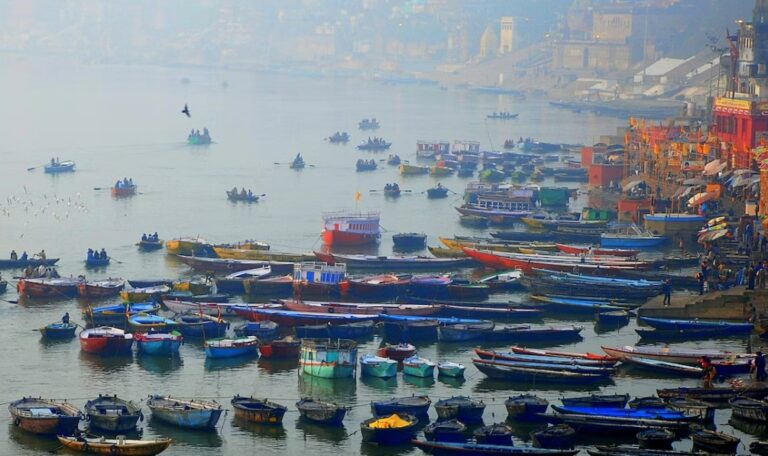Rivers are the lifelines of our planet, providing essential resources for billions of people and a variety of wildlife. However, human activities have taken a toll on these precious water bodies, leading to pollution and environmental degradation. We will explore the top 10 most polluted rivers in the world, highlighting the countries they flow through and the devastating consequences of their contamination.
Table of Contents
1. Ganges river – India
The Ganges river, also renowned as the Ganga, holds momentous cultural and spiritual eminence in the nation of India. Tragically, it stands as one of the most polluted rivers on a global scale, confronting myriad environmental quandaries.
Catering water to approximately 40% of India’s populace spanning 11 states, serving an estimated multitude of 500 million individuals, it ascends as the most densely inhabited river basin worldwide.
The pollution predominantly emanates from industrial effluents, untreated sewage, and religious practices entailing the dispersal of ashes and other ceremonial paraphernalia into the sacred river. The contamination endured by the Ganges river intertwines with India’s escalated incidence of waterborne afflictions, amounting to the loss of an estimated 1.5 million lives.
2. Citarum river – Indonesia
Now, in the realm of Indonesia, the Citarum river confronts formidable pollution stemming from industrial detritus and domestic refuse. This once-vital water source for agriculture and potable usage is now asphyxiated by plastic waste and chemical residue, harboring substantial health hazards for its dependents.
The pollution’s origins can be traced back to industrial and household residues, with over 2,000 industrial facilities located near the river channel negligently depositing toxic chemicals, including arsenic and lead, into its flowing waters.
3. Yellow river – China
The Yellow river, often hailed as the “Birthplace of Chinese Civilization,” grapples with severe contamination owing to discharges from industries and runoff from agricultural practices.
Annually, a staggering four billion tons of wastewater, constituting 10 percent of the river’s total volume, finds its way into the Yellow river. As a consequence, the water quality of this river has experienced a drastic decline, adversely impacting aquatic life and the communities residing along its scenic banks.
Read more: How to prevent water pollution in 8 simple ways
4. Sarno river – Italy
On the Italian terrain, the Sarno river confronts formidable challenges of pollution, predominantly emanating from illicit waste disposal and industrial undertakings.
The irresponsible dumping of hazardous substances has transformed the once pristine river. It is now a perilous waterway, causing harm to both the environment and human well-being.
5. Buriganga river – Bangladesh
In the heart of Bangladesh’s capital city, Dhaka, meanders the Buriganga River, confronted by a grave crisis of pollution. Each passing day, the city disgorges approximately 4,500 tons of solid waste, with a significant portion finding its way into Buriganga’s waters.
The unabated dumping of untreated industrial waste has contributed to the contamination of the river. In addition, haphazard disposal of plastics and other refuse has worsened the situation. As a result, the once-vibrant river in Bangladesh is now one of the most polluted rivers and waterways in the country.
6. Marilao river – Philippines
On Philippine soil, the Marilao river grapples with an unparalleled pollution dilemma stemming from the perilous presence of heavy metals and toxic chemicals. The industrial endeavors in the vicinity have caused havoc on the river’s delicate ecosystem.
Additionally, they have also negatively impacted the well-being of nearby communities. Bereft of biological life since 1989, the Marilao river stands as a major tributary of Manila Bay, its waters now devoid of oxygen, rendering it inhospitable to any form of life, turning it into one of the most polluted rivers.
7. Mississippi river – United States
The Mississippi River, known as one of the world’s longest rivers, faces a significant challenge with pollution. This pollution mainly arises from agricultural runoff, industrial discharges, and urban expansion. These factors contribute to the river’s current daunting predicament.
These insidious pollutants have fostered the emergence of lifeless zones and now pose a menacing threat to the river’s precious biodiversity.
With an estimated 1.5 million metric tons of nitrogen pollution being transported annually into the Gulf of Mexico, the Mississippi river becomes a harrowing harbinger of a vast “dead zone” that stretches across the Gulf’s expanse.
8. Yamuna river – India
In the Indian subcontinent, the Yamuna river holds a similar burden of pollution as its revered counterpart, the Ganges. This pollution is largely attributed to industrial waste and untreated sewage. Despite commendable endeavors aimed at cleansing the river’s waters, the Yamuna remains an acute environmental concern.
The 22 km stretch between the Wazirabad barrage to Okhla Barrage in Delhi is of particular significance. Despite accounting for less than 2% of the river’s total length, this small section bears the burden of nearly 80% of the overall pollution afflicting the Yamuna.
9. Jordan river – Middle East
Nestled in the heart of the Middle East, the Jordan river holds profound historical significance for various religions. However, it now grapples with pressing pollution issues. These problems have grievously impacted its once-pure flow and pristine water quality. Over the years, the unbridled discharge of untreated sewage and agricultural runoff has wrought contamination upon its sacred waters.
The lower Jordan River is particularly affected, bearing the brunt of extreme pollution. This pollution originates from raw sewage and contaminated agricultural runoff streaming in from neighboring communities in Israel, the West Bank, and Jordan.
10. Matanza-Riachuelo river – Argentina
On the South American terrain, the Matanza-Riachuelo river in Argentina finds itself in the throes of severe pollution owing to industrial waste and unchecked urban development. This distressing contamination poses significant health concerns for the communities residing in close proximity to its meandering banks.
Remarkably, the plight of pollution has persisted for almost two centuries. The river has continuously faced contamination from heavy metals, chemicals, and organic waste. This pollution has left a haunting imprint on its once-pristine landscape.
Read more: Blue Economy: what is it and what are its main components and principles












